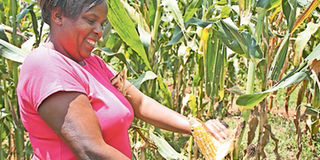Old is gold, researchers say on underutilised indigenous crops

Ann Nyambura in her yellow-maize farm in Nakuru. While the crop is usually generally associated with animal feeds and is known to have been utilised by humans during food shortage seasons in the past, laboratory tests indicate it is rich in iron, zinc and it is energy dense. PHOTO | RACHEL KIBUI | NMG
What you need to know:
- This discussion was triggered by research on 10 crops which are nutritionally rich and were important in the past but these days they are underutilised.
- The research, funded by Hivos, a development organisation headquartered in the Netherlands, also involved taking the edible parts of these crops to a laboratory for nutritional analysis.
- During the study, traditional knowledge from farmers linked pumpkin seeds to increased libido for men and women of menauposal age. Scientific knowledge, however, shows the seeds have plenty of zinc.
- Cherry tomato was found to be rich in iron, crude protein and fibre. The crop does not need to be sprayed against pests and diseases as it is hardy.
At Kampi ya Moto village in Rongai, Nakuru County, a group of farmers met last month — as usual.
But on this day, the members of Kampi Farmers Group were discussing two crops, red sorghum and red millet.
“In Bunyore, farmers would exchange red millet and red sorghum for clay pots,” said Noah Osumba, adding that the barter trade, which his grandmother enjoyed as a farmer, thrived during the harvesting season.
Another member recalled that red sorghum was used to prepare a githeri-like meal, which was known as muthura.
Additionally, the grain was roasted to prepare a beverage used in place of tea.
Both crops, as the farmers noted, were important, especially in preparation of fermented porridge, which was good for lactating mothers.
This discussion was triggered by research on 10 crops which are nutritionally rich and were important in the past but these days they are underutilised.
The research carried out in several villages across Nakuru by Seed Savers Network, a Gilgil-based community organisation, saw the researchers gather indigenous knowledge about the crops, including how they were grown, utilised, stored and used economically.
The research, funded by Hivos, a development organisation headquartered in the Netherlands, also involved taking the edible parts of these crops to a laboratory for nutritional analysis.
The results were then discussed with a nutritionist, who explained the benefits of nutrients found in each of the crops.
AWARENESS ON UNDERUTILISED CROPS
Besides red sorghum and red millet, other crops researched on include yellow maize, goose berries, cherry tomatoes, common beans, black beans, black night shade, red cowpeas and pumpkin.
The aim of the research was to find ways to popularise the crops, whose fortunes have declined among modern farmers.
During the study, traditional knowledge from farmers linked pumpkin seeds to increased libido for men and women of menauposal age. Scientific knowledge, however, shows the seeds have plenty of zinc.
“Pumpkin seeds have high levels of zinc, which is a macronutrient that enhances fertility; hence its association with fertility,” said Lillian Marita, Nakuru County’s nutrition co-ordinator.
While yellow maize is associated with animal feeds and is known to have been utilised by humans during food shortage seasons in the past, laboratory tests indicated that this crop is rich in iron, zinc and it is energy dense.
“It is because of its energy-dense nature that farmers said that if one consumed a little yellow-maize meal, he or she remained full the entire day,” said Lillian.
Cherry tomato was found to be rich in iron, crude protein and fibre. The crop does not need to be sprayed against pests and diseases as it is hardy.
Seed Savers Network coordinator Daniel Wanjama said the organisation will be creating awareness on the underutilised crops to encourage people to plant and eat them.
“The crops are also easy to grow and quite adaptive to harsh weather conditions,” he said.





